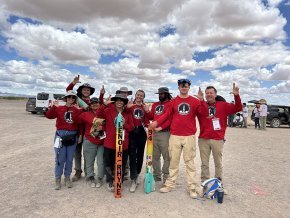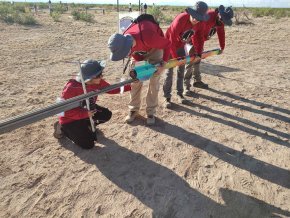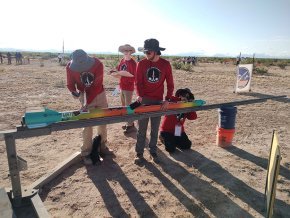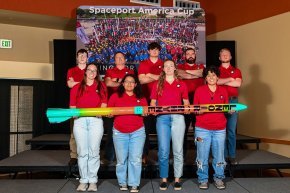
AeroBears aim to top 2024 successes
After their highest-ever finish at the 2024 Spaceport America Cup in New Mexico over the summer, the Lenoir-Rhyne University AeroBears rocketry team members are eager to reach even higher in 2025.

In June, the team took their sounding rocket nicknamed “the Solar Polar Bear,” to Las Cruces, New Mexico to participate in the Spaceport America Cup for the fourth year in a row. Out of a field of 122 invited participants from around the globe, LR placed 26th – in the 21st percentile – ahead of much larger teams and ahead of other competitors from North Carolina, including our neighbors to the east at Duke University.
The rocket’s name included a reference to the team’s participation in a NASA-sponsored balloon launch during the solar eclipse in April and, of course, the LR mascot.
“A few other students and I designed the color scheme, which I loved,” shared mathematics major and payload leader Demmi Ramos ’25. “We’ve always done the school colors in the past, so this time we went with colors that would reflect the name Solar Polar Bear. A lot of the other teams told us we had the prettiest rocket at the competition – and the design did count as part of our score.”
The larger factor in the team’s success appeared in their connection to one another and willingness to cooperate.
“It was just a great bunch of people, really focused and mature, but they also knew how to have fun – just really cool to be around,” said team advisor and physics professor Doug Knight, Ph.D. “The invitations they got for events and their results in competition reflect the bonds of the team, their work ethic and their knowledge. This year we want to grow the team even more so we can expand on those successes.”
The thrill of competition
The Spaceport America Cup is the apex of the annual rocketry “season,” the event the team prepares for, starting in the fall semester with recruiting new team members as well as sponsors for materials and transport. Over the course of the year, the team builds their rocket and tests motors, fuel and payload configurations with launches at a designated range in South Carolina.
“Getting everything to work as you want it to, when you want it to happen is probably the hardest part of rocketry,” Dr. Knight shared. “There are a lot of moving parts – literally – and one little detail can cancel everything else, and there are no second chances. That’s true for the professionals as much as it is for us, but that risk is what makes a launch so exciting.”

While the isolation and space of the New Mexico desert makes it a desirable location to host the world’s largest rocketry competition, unpredictable winds and weather patterns can challenge even the best-prepared teams and their plans. This year violent windstorms at the launch site delayed the Solar Polar Bear’s scheduled launch time by a day, which pressed the team to make a difficult decision to keep the rocket safe from wind damage overnight.
“We had already been through the range safety inspection – which is a lengthy process. So, we had the option to either take the rocket with us and go through inspection again in the morning or secure it there overnight and hope the batteries in the payload would still have some charge when we launched,” explained chemistry major Erica Schulz ’24. “It was a hard conversation, but the payload team sacrificed some battery-run parts of the payload so we could launch on time the next day, which definitely affected our launch performance.”
Payload leader Demmi Ramos ’25, focused on their priorities to make the decision to risk the payload batteries and secure the rocket overnight.

“When it came down to it, my main goal was the cameras,” said Ramos. “I just wanted the camera footage. It was really scary because we couldn’t access them through WiFi, and we cut it really close on the battery life, but we got the footage. It was unbelievable!”
The result was a nearly perfect nominal launch – meaning the rocket landed undamaged, in a condition that could simply refuel and fly again.
“We tracked it on the instruments, but the skies were nice and clear, so we had really good vision seeing the rocket on the way up. A few students could see it at apogee, almost 10,000 feet,” shared computer science major Mike Gerbitz, ’25. “Then we could see it coming back down at the velocity it’s supposed to, in a straight line – when you physically see it, that’s the best thing in the world.”
Looking to the future
At its core, rocketry is an exercise in creative problem solving, so one key strength of the team is the diversity of academic perspectives making up their numbers.
“We only had one engineering physics major on the team,” said Schulz. “The rest of the team is all over the board – STEM majors, non-STEM majors. We have a finance major who got recognized by the judges for his organization and use of checklists in the launch. We have a communications major who has boosted our social media presence. Criminal justice, math, psychology, computer science – they’re also seeing how this can be more than just a cool thing to do in college. It’s also real preparation for a career. This opens real doors for people.”
The multifaceted LR team caught the eye of aerospace industry recruiters in the convention space at Spaceport America – starting with a first-place finish in the annual trivia contest among the collegiate teams, then with the range of their interests and experience.

“I completed an internship with NASA this summer, and engineers are not the whole story,” shared team leader Caleb Knight ’24, now a graduate student in physics at the University of Alabama at Birmingham. “You need scientists in labs. You need people handling budgets, programming computers, securing the facilities, talking to the press – there’s a place for every major in the industry, and there’s a place for them on this team.”
The team doubled in size in 2023 and 2024, from five to nine members, spurring Caleb Knight’s hopes the team will continue to grow, cultivate different personalities and attract different majors.
“We all complimented each other,” he shared. “We listened to each other and respected each other, and that pulled it all together. If you work from that foundation, you can accomplish pretty much anything.”

LR students Lindsay Gustafson ’27, Cody Stagner ’27, Brysen Rodriguez ’28 and Aaron Hollar ’26 joined the 2025 North Carolina Intercollegiate Honor Band, showcasing talent, teamwork and collaboration.
View More
Lenoir-Rhyne is charging forward—removing barriers, expanding opportunity and shaping tomorrow’s leaders through a preeminent, purpose-driven student experience.
View More